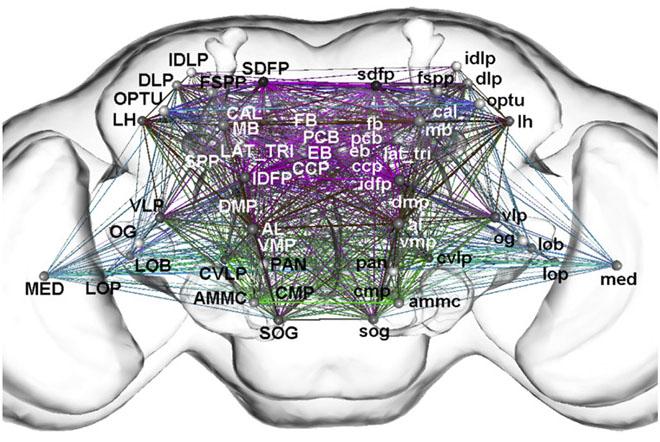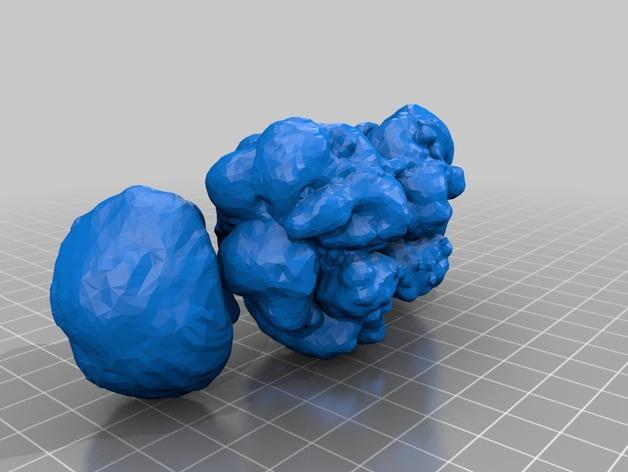 I have a thing for lamps, but until now I’d never considered adding one to my collection that in its illumination is a 3D printed map relaying scientific data from a fruit fly brain. While delighted at the thought of trying to explain this to someone admiring it in my living room, I am not so sure about pulling it off as a DIY project. That, however, was a ‘no-brainer’ for Nicolas Aimon, who wanted to make a tangible display of the research his sister was interested in, as well as get his hands on the new FormLabs 3D printer in his MIT research lab.
I have a thing for lamps, but until now I’d never considered adding one to my collection that in its illumination is a 3D printed map relaying scientific data from a fruit fly brain. While delighted at the thought of trying to explain this to someone admiring it in my living room, I am not so sure about pulling it off as a DIY project. That, however, was a ‘no-brainer’ for Nicolas Aimon, who wanted to make a tangible display of the research his sister was interested in, as well as get his hands on the new FormLabs 3D printer in his MIT research lab.
Nicolas Aimon, post-doctoral associate at MIT, found the research his sister Sophie was doing on fruit fly brains to be illuminating — so much so that he wanted to put her scientific data in lights, literally. While not at work in MIT’s Department of Materials Science and Engineering where they research new materials, device architectures and bottom-up fabrication methods for memory, logic, and photonic devices, Aimon set his sights on taking his sister’s scientific data from the computer screen to a 3D model.
Sophie Aimon, post-doctoral associate studying at Kavli Institute for Brain and Mind at UC San Diego at the research laboratory of Professor Ralph Greenspan, was studying networks in the brains of fruit flies to figure out how interactions in the brain, in general, are coordinated and bound together ‘to produce coherent percepts and action.’ They chose to test their ideas on the brains of fruit flies because they are small and established enough for using genetically encoded calcium sensors which offer wide, efficient samples of data where they can figure out what is going on in the brain all at once.
And how would a fruit fly brain even remotely correlate with the human brain? According to Professor Greenspan’s study, you would be quite surprised. In the study, the researchers point out that drosophila melanogaster and other invertebrates are similar to vertebrate embryos in early nervous system gene expression, continuing later, and also including the structure of the cortex.

Map showing wiring connections among local processing units of the Drosophila brain. (Chiang et al., 2011)
It just so happened that MIT had a new Formlabs 3D printer which, Mr. Aimon explains, has “great print resolution and allows to make models in a transparent resin.” He began working on a design to make a 3D printed model that would illustrate his sister’s data, which uses microscopy techniques to examine the fruit fly data.
Mr. Aimon knew it would be much more helpful — and exciting — to view this data in a tangible 3D model. He downloaded a model of the fruit fly brain, and after refining the file a bit, uploaded it to Thingiverse. His next challenge was in configuring the illumination for the model, which he did by:
- Creating a grid with 53 spheres to insert fibers for model illumination.
- Created guides for inserting the fibers.
- Gluing the fibers with epoxy glue.
- Using a string of LEDs — Adafruit NeoPixels — to light up display and control color.
- Modifying a hardboard box with holes for the fibers and to house the Arduino board, with an access to the USB port.

 Mr. Aimon’s final challenge was to display the data, converting the information to the positions of the fibers, according to the coordinates fo
Mr. Aimon’s final challenge was to display the data, converting the information to the positions of the fibers, according to the coordinates fo
r the spheres, allowing him to assign light intensities, which he was able to test against the data for accuracy. The end product was a 3D printed model using optical fibers to demonstrate the fruit fly’s brain activity.
Does this inspire you to design and 3D print something similar? What are your thoughts on Aimon’s project? Tell us about it in the 3D printed Fruit Fly Brain forum thread at 3DPB.com.
Check out these videos with placements for the project:
Subscribe to Our Email Newsletter
Stay up-to-date on all the latest news from the 3D printing industry and receive information and offers from third party vendors.
You May Also Like
Profiling a Construction 3D Printing Pioneer: US Army Corps of Engineers’ Megan Kreiger
The world of construction 3D printing is still so new that the true experts can probably be counted on two hands. Among them is Megan Kreiger, Portfolio Manager of Additive...
US Army Corps of Engineers Taps Lincoln Electric & Eaton for Largest 3D Printed US Civil Works Part
The Soo Locks sit on the US-Canadian border, enabling maritime travel between Lake Superior and Lake Huron, from which ships can reach the rest of the Great Lakes. Crafts carrying...
Construction 3D Printing CEO Reflects on Being Female in Construction
Natalie Wadley, CEO of ChangeMaker3D, could hear the words of her daughter sitting next to her resounding in her head. “Mum, MUM, you’ve won!” Wadley had just won the prestigious...
1Print to Commercialize 3D Printed Coastal Resilience Solutions
1Print, a company that specializes in deploying additive construction (AC) for infrastructure projects, has entered an agreement with the University of Miami (UM) to accelerate commercialization of the SEAHIVE shoreline...

































